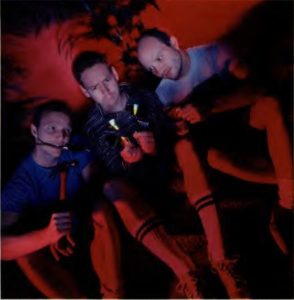
In this vaguely disturbing picture of Toys for Bob from 1994, Paul Reiche is at center and Fred Ford to the left. Ken Ford, who joined shortly after Star Control II was completed, is to the right.
There must have been something in the games industry’s water circa 1992 when it came to the subject of sequels. Instead of adhering to the traditional guidelines — more of the same, perhaps a little bigger — the sequels of that year had a habit of departing radically from their predecessors in form and spirit. For example, we’ve recently seen how Virgin Games released a Dune II from Westwood Studios that had absolutely nothing to do with the same year’s Dune I, from Cryo Interactive. But just as pronounced is the case of Accolade’s Star Control II, a sequel which came from the same creative team as Star Control I, yet which was so much more involved and ambitious as to relegate most of what its predecessor had to offer to the status of a mere minigame within its larger whole. In doing so, it made gaming history. While Star Control I is remembered today as little more than a footnote to its more illustrious successor, Star Control II remains as passionately loved as any game from its decade, a game which still turns up regularly on lists of the very best games ever made.
Like those of many other people, Paul Reiche III’s life was irrevocably altered by his first encounter with Dungeons & Dragons in the 1970s. “I was in high school,” he remembers, “and went into chemistry class, and there was this dude with glasses who had these strange fantasy illustrations in front of him in these booklets. It was sort of a Napoleon Dynamite moment. Am I repulsed or attracted to this? I went with attracted to it.”
In those days, when the entire published corpus of Dungeons & Dragons consisted of three slim, sketchy booklets, being a player all but demanded that one become a creator — a sort of co-designer, if you will — as well. Reiche and his friends around Berkeley, California, went yet one step further, becoming one of a considerable number of such folks who decided to self-publish their creative efforts. Their most popular product, typed out by Reiche’s mother on a Selectric typewriter and copied at Kinko’s, was a book of new spells called The Necromican.
That venture eventually crashed and burned when it ran afoul of that bane of all semi-amateur businesses, the Internal Revenue Service. It did, however, help to secure for Reiche what seemed the ultimate dream job to a young nerd like him: working for TSR itself, the creator of Dungeons & Dragons, in Lake Geneva, Wisconsin. He contributed to various products there, but soon grew disillusioned by the way that his own miserable pay contrasted with the rampant waste and mismanagement around him, which even a starry-eyed teenage RPG fanatic like him couldn’t fail to notice. The end came when he spoke up in a meeting to question the purchase of a Porsche as an executive’s company car. That got him “unemployed pretty dang fast,” he says.
So, he wound up back home, attending the University of California, Berkeley, as a geology major. But by now, it was the 1980s, and home computers — and computer games — were making their presence felt among the same sorts of people who tended to play Dungeons & Dragons. In fact, Reiche had been friends for some time already with one of the most prominent designers in the new field: Jon Freeman of Automated Simulations, designer of Temple of Apshai, the most sophisticated of the very early proto-CRPGs. Reiche got his first digital-game credit by designing The Keys of Acheron, an “expansion pack” for Temple of Apshai‘s sequel Hellfire Warrior, for Freeman and Automated. Not long after, Freeman had a falling-out with his partner and left Automated to form Free Fall Associates with his wife, programmer Anne Westfall. He soon asked Reiche to join them. It wasn’t a hard decision to make: compared to the tabletop industry, Reiche remembers, “there was about ten times the money in computer games and one-tenth the number of people.”
Freeman, Westfall, and Reiche made a big splash very quickly, when they were signed as one of the first group of “electronic artists” to join a new publisher known as Electronic Arts. Free Fall could count not one but two titles among EA’s debut portfolio in 1983: Archon, a chess-like game where the pieces fought it out with one another, arcade-style, under the players’ control; and Murder on the Zinderneuf, an innovative if not entirely satisfying procedurally-generated murder-mystery game. While the latter proved to be a slight commercial disappointment, the former more than made up for it by becoming a big hit, prompting the trio to make a somewhat less successful sequel in 1984.
After that, Reiche parted ways with Free Fall to become a sort of cleanup hitter of a designer for EA, working on whatever projects they felt needed some additional design input. With Evan and Nicky Robinson, he put together Mail Order Monsters, an evolution of an old Automated Simulations game of monster-movie mayhem, and World Tour Golf, an allegedly straight golf simulation to which the ever-whimsical Reiche couldn’t resist adding a real live dinosaur as the mother of all hazards on one of the courses. Betwixt and between these big projects, he also lent a helping hand to other games: helping to shape the editor in Adventure Construction Set, making some additional levels for Ultimate Wizard.
Another of these short-term consulting gigs took him to a little outfit called Binary Systems, whose Starflight, an insanely expansive game of interstellar adventure, had been in production for a couple of years already and showed no sign of being finished anytime soon. This meeting would, almost as much as his first encounter with Dungeons & Dragons, shape the future course of Reiche’s career, but its full import wouldn’t become clear until years later. For now, he spent two weeks immersed in the problems and promise of arguably the most ambitious computer game yet proposed, a unique game in EA’s portfolio in that it was being developed exclusively for the usually business-oriented MS-DOS platform rather than a more typical — and in many ways more limited — gaming computer. He bonded particularly with Starflight‘s scenario designer, an endlessly clever writer and artist named Greg Johnson, who was happily filling his galaxy with memorable and often hilarious aliens to meet, greet, and sometimes beat in battle.
Reiche’s assigned task was to help the Starflight team develop a workable conversation model for interacting with all these aliens. Still, he was thoroughly intrigued with all aspects of the project, so much so that he had to be fairly dragged away kicking and screaming by EA’s management when his allotted tenure with Binary Systems had expired. Even then, he kept tabs on the game right up until its release in 1986, and was as pleased as anyone when it became an industry landmark, a proof of what could be accomplished when designers and programmers had a bigger, more powerful computer at their disposal — and a proof that owners of said computers would actually buy games for them if they were compelling enough. In these respects, Starflight served as nothing less than a harbinger of computer gaming’s future. At the same, though, it was so far out in front of said future that it would stand virtually alone for some years to come. Even its sequel, released in 1989, somehow failed to recapture the grandeur of its predecessor, despite running in the same engine and having been created by largely the same team (including Greg Johnson, and with Paul Reiche once again helping out as a special advisor).
Well before Starflight II‘s release, Reiche left EA. He was tired of working on other people’s ideas, ready to take full control of his own creative output for the first time since his independent tabletop work as a teenager a decade before. With a friend named Fred Ford, who was the excellent programmer Reiche most definitely wasn’t, he formed a tiny studio — more of a partnership, really — called Toys for Bob. The unusual name came courtesy of Reiche’s wife, a poet who knew the value of words. She said, correctly, that it couldn’t help but raise the sort of interesting questions that would make people want to look closer — like, for instance, the question of just who Bob was. When it was posed to him, Reiche liked to say that everyone who worked on a Toys for Bob game should have his own Bob in mind, serving as an ideal audience of one to be surprised and delighted.
Reiche and Ford planned to keep their company deliberately tiny, signing only short-term contracts with outsiders to do the work that they couldn’t manage on their own. “We’re just people getting a job done,” Reiche said. “There are no politics between [us]. Once you start having art departments and music departments and this department and that department, the organization gets a life of its own.” They would manage to maintain this approach for a long time to come, in defiance of all the winds of change blowing through the industry; as late as 1994, Toys for Bob would permanently employ only three people.
Yet Reiche and Ford balanced this small-is-beautiful philosophy with a determination to avoid the insularity that could all too easily result. They made it a policy to show Toys for Bob’s designs-in-progress to many others throughout their evolution, and to allow the contractors they hired to work on them the chance to make their own substantive creative inputs. For the first few years, Toys for Bob actually shared their offices with another little collective who called themselves Johnson-Voorsanger Productions. They included in their ranks Greg Johnson of Starflight fame and one Robert Leyland, whom Reiche had first met when he did the programming for Murder on the Zinderneuf — Anne Westfall had had her hands full with Archon — back in the Free Fall days. Toys for Bob and Johnson-Voorsanger, these two supposedly separate entities, cross-pollinated one another to such an extent that they might almost be better viewed as one. When the latter’s first game, the cult-classic Sega Genesis action-adventure ToeJam & Earl, was released in 1991, Reiche and Ford made the credits for “Invaluable Aid.” And the influence which Leyland and particularly Johnson would have on Toys for Bob’s games would be if anything even more pronounced.
Toys for Bob’s first game, which they developed for the publisher Accolade, was called Star Control. With it, Reiche looked all the way back to the very dawn of digital gaming — to the original Spacewar!, the canonical first full-fledged videogame ever, developed on a DEC PDP-1 at the Massachusetts Institute of Technology circa 1962. In Star Control as in Spacewar!, two players — ideally, two humans, but potentially one human and one computer player, or even two computer players if the “Cyborg Mode” is turned on — fight it out in an environment that simulates proper Newtonian physics, meaning objects in motion stay in motion until a counter-thrust is applied. Players also have to contend with the gravity wells of the planets around them — these in place of the single star which affects the players’ ships in Spacewar! — as they try to blow one another up. But Star Control adds to this formula a wide variety of ships with markedly differing weaponry, defensive systems, sizes, and maneuvering characteristics. In best rock-paper-scissors fashion, certain units have massive advantages over others and vice versa, meaning that a big part of the challenge is that of maneuvering the right units into battle against the enemy’s. As in real wars, most of the battles are won or lost before the shooting ever begins, being decided by the asymmetries of the forces the players manage to bring to bear against one another. Reiche:
It was important to us that each alien ship was highly differentiated. What it means is, unlike, say, Street Fighter, where your characters are supposedly balanced with one another, our ships weren’t balanced at all, one on one. One could be very weak, and one could be very strong, but the idea was, your fleet of ships, your selection of ships in total, was as strong as someone else’s, and then it came down to which match-up did you find. One game reviewer called it, “Rock, Scissors, Vapor,” which I thought was a great expression.
Of course, even the worst match-ups leave a sliver of hope that a brilliant, valorous performance on the field of battle can yet save the day.
You can play Star Control in “Melee” mode as a straight-up free-for-all. Each player gets seven unique ships from the fourteen in the game, from which she gets to choose one for each battle. First player to destroy all of her opponent’s ships wins. But real strategy — that is to say, strategy beyond the logic of rock-paper-scissors match-ups — comes into play only with the full game, which takes the form of a collection of scenarios where each player must deploy her fleet over a galactic map. In the more complex scenarios, controlling more star systems means more resources at one’s disposal, which can be used to build more and better ships at a player’s home starbase; this part of the game draws heavily from the beloved old Atari 8-bit classic Star Raiders. A scenario editor is also included for players who get bored with the nine scenarios that come with the game.
Star Control strains nobly to accommodate many different play styles and preferences. Just as it’s possible to turn on Cyborg Mode in the strategy game and let the computer do the fighting, it’s also possible to turn on “Psytron Mode” and let the computer do the strategy while you concentrate on blowing stuff up.
Yet the aspect of Star Control that most players seem to remember best has nothing to do with any of these efforts to be all things to all players. At some point in the development process, Reiche and Ford realized they needed a context for all this interstellar violence. They came up with an “Alliance of Free Stars” — which included Earthlings among its numbers — fighting a war against the evil “Ur-Quan Hierarchy.” Each group of allies/thralls conveniently consists of seven species, each with their own unique model of spaceship. Not being inclined to take any of this too seriously, Toys for Bob let their whimsy run wild in creating all these aliens, enlisting Greg Johnson — the creator of the similarly winsome and hilarious aliens who inhabit the galaxy of Starflight — to add his input as well. The rogue’s gallery of misfits, reprobates, and genetic oddities that resulted can’t help but make you smile, even if they are more fleshed-out in the manual rather than on the screen.
Reiche on the origins of the Ilwrath, a race of arachnid fundamentalists who “receive spiritual endorsement in the accomplishment of vicious surprise attacks”:
The name “Ilwrath” comes from an envelope I saw at the post office, which was being sent to a Ms. McIlwrath in Glasgow, Scotland. I didn’t see the “Mc” at first, and I swear, my first thought was that they must be sending that envelope to an alien. I am sure that somewhere there is a nice little Scottish lady laughing and saying, “Oh, those crazy Americans! Here’s one now calling me an evil, giant, religiously-intolerant space spider — ha, ha, ha, how cute!” Hmm… on second thought, if I am ever found beaten with bagpipes or poisoned with haggis, please contact the authorities.
Around the office, Fred Ford liked to say that the Ilwrath had become so darn evil by first becoming too darn righteous, wrapping right around the righteousness scale and yielding results akin to all those old computer games which suddenly started showing negative statistics if you built up your numbers too far. (Personally, I favor this idea greatly, and, indeed, even believe it might serve as an explanation for certain forces in current American politics.)
Reiche on the Mmrnmhrm, an “almost interesting robot race” who “fear vowels almost as much as they do a Dreadnought closing in at full bore”:
When I first named the Mmrnmhrm, they actually had a pronounceable name, with vowels and everything. Then, in a sketch for the captain’s window illustration, I forgot to give them a mouth. Later, someone saw the sketch and asked me how they talked, so I clamped my lips shut and said something like, “Mrrk nsss,” thereby instituting a taboo on vowels in anything related to the race. Though the Mmrnmhrm ended up looking more like Daleks than Humans, the name stuck.
Reiche on the Syreen, a group of “humanoid females” who embody — knowingly, one likes to believe — every cliché about troglodyte gamers and the fairer sex, right down to their bulbous breasts that look like they’re filled with sand (their origin story also involves the San Francisco earthquake of 1989):
It was an afternoon late last October in San Francisco when Fred Ford, Greg Johnson, and I sat around a monitor trying to name the latest ship design for our new game. The space vessel on the computer screen looked like a copper-plated cross between Tin Tin’s Destination Moon rocketship and a ribbed condom. Needless to say, we felt compelled to christen this ship carefully, with due consideration for our customers’ sensibilities as well as our artistic integrity. “How about the Syreen Penetrator?” Fred suggested without hesitation. Instantly, the ground did truly rise up and smite us! WHAM-rumble-rumble-WHAM! We were thrown around our office like the bridge crew of the starship Enterprise when under fire by the Klingons. I dimly remember standing in a doorframe, watching the room flex like a cheap cardboard box and shouting, “Maybe that’s not such a great name!” and “Gee, do you think San Francisco’s still standing?” Of course, once the earth stopped moving, we blithely ignored the dire portent, and the Syreen’s ship name, “The Penetrator,” was graven in code.
Since then, we haven’t had a single problem. I mean, everyone has a disk crash two nights before a program is final, right? And hey, accidents happen. Brake pads just don’t last forever! My limp is really not that bad, and Greg is almost speaking normally these days.
Star Control was released in 1990 to cautiously positive reviews and reasonable sales. For all its good humor, it proved a rather polarizing experience. The crazily fast-paced action game at its heart was something that about one-third of players seemed to take to and love, while the rest found it totally baffling, being left blinking and wondering what had just happened as the pieces of their exploded ship drifted off the screen about five seconds after a fight had begun. For these people, Star Control was a hard sell: the strategic game just wasn’t deep enough to stand on its own for long, and, while the aliens described in the manual were certainly entertaining, this was a computer game, not a Douglas Adams book.
Still, the game did sufficiently well that Accolade was willing to fund a sequel. And it was at this juncture that, as I noted at the beginning of this article, Reiche and Ford and their associates went kind of nuts. They threw out the less-than-entrancing strategy part of the first game, kept the action part and all those wonderful aliens, and stuck it all into a grand adventure in interstellar space that owed an awful lot to Starflight — more, one might even say, than it owed to Star Control I.
As in Starflight, you roam the galaxy in Star Control II: The Ur-Quan Masters to avert an apocalyptic threat, collecting precious resources and even more precious clues from the planets you land on, negotiating with the many aliens you meet and sometimes, when negotiations break down, blowing them away. The only substantial aspect of the older game that’s missing from its spiritual successor is the need to manage a bridge crew who come complete with CRPG-style statistics. Otherwise, Star Control II does everything Starflight does and more. The minigame of resource collection on planets’ surfaces, dodging earthquakes and lightning strikes and hostile lifeforms, is back, but now it’s faster paced, with a whole range of upgrades you can add to your landing craft in order to visit more dangerous planets. Ditto space combat, which is now of the arcade style from Star Control I — if, that is, you don’t have Cyborg Mode turned on, which is truly a godsend, the only thing that makes the game playable for many of us. You still need to upgrade your ship as you go along to fight bigger and badder enemies and range faster and farther across space, but now you also can collect a whole fleet of support ships to accompany you on your travels (thus preserving the rock-paper-scissors aspect of Star Control I). I’m not sure that any of these elements could quite carry a game alone, but together they’re dynamite. Much as I hate to employ a tired reviewer’s cliché like “more than the sum of its parts,” this game makes it all but unavoidable.
And yet the single most memorable part of the experience for many or most of us remains all those wonderful aliens, who have been imported from Star Control I and, even better, moved from the pages of the manual into the game proper. Arguably the most indelible of them all, the one group of aliens that absolutely no one ever seems to forget, are the Spathi, a race of “panicked mollusks” who have elevated self-preservation into a religious creed. Like most of their peers, they were present in the first Star Control but really come into their own here, being oddly lovable despite starting the game on the side of the evil Ur-Quan. The Spathi owe more than a little something to the Spemin, Starflight‘s requisite species of cowardly aliens, but are based at least as much, Reiche admits a little sheepishly, on his own aversion to physical danger. Their idea of the perfect life was taken almost verbatim from a conversation about same that Reiche and Ford once had over Chinese food at the office. Here, then, is Reiche and the Spathi’s version of the American Dream:
I knew that someday I would be vastly rich, wealthy enough to afford a large, well-fortified mansion. Surrounding my mansion would be vast tracts of land, through which I could slide at any time I wished! Of course, one can never be too sure that there aren’t monsters hiding just behind the next bush, so I would plant trees to climb at regular, easy-to-reach intervals. And being a Spathi of the world, I would know that some monsters climb trees, though often not well, so I would have my servants place in each tree a basket of perfect stones. Not too heavy, not too light — just the right size for throwing at monsters.
“Running away and throwing rocks,” explains Reiche, “extrapolated in all ways, has been one of my life strategies.”
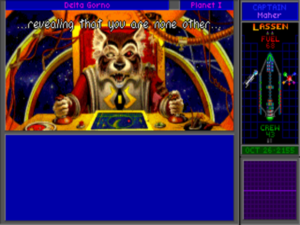
The Shofixti, who breed like rabbits. Put the one remaining female in the galaxy together with the one remaining male, wait a couple of years… and poof, you have an army of fuzzy little warmongers on your side. They fight with the same enthusiasm they have for… no, we won’t go there.
My personal favorite aliens, however, are the bird-like Pkunk, a peaceful, benevolent, deeply philosophical race whose ships are nevertheless fueled by the insults they spew at their enemies during battle. They are, of course, merely endeavoring to make sure that their morality doesn’t wrap back around to zero and turn them evil like the Ilwrath. “Never be too good,” says Reiche. “Insults, pinching people when they aren’t looking… that’ll keep you safe.”
In light of the aliens Greg Johnson had already created for Starflight, not to mention the similarities between Starflight‘s Spemin and Star Control‘s Spathi, there’s been an occasional tendency to perhaps over-credit his contribution — valuable though it certainly was — to Toys for Bob’s own space epic. Yet one listen to Reiche and Ford in interviews should immediately disabuse anyone of the notion that the brilliantly original and funny aliens in Star Control II are there entirely thanks to Johnson. After listening to Reiche in particular for a few minutes, it really is blindingly obvious that this is the sense of humor behind the Spathi and so many others. Indeed, anyone who has played the game can get a sense of this just from reading some of his quotes in this very article.
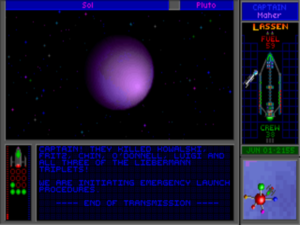
There’s a rich vein of story and humor running through even the most practical aspects of Star Control II, as in this report from a planet’s surface. The two complement one another rather than clashing, perhaps because Toys for Bob is clever enough to understand that less is sometimes more. Who are the Liebermann triplets? Who knows? But the line makes you laugh, and that’s the important thing. When a different development team took the reins to make a Star Control III, Reiche’s first piece of advice to them was, “For God’s sake, don’t try to explain everything.” Many a lore-obsessed modern game could afford to take the same advice to heart.
Long after every other aspect of the game has faded from memory, its great good humor, embodied in all those crazy aliens, will remain. It may be about averting a deadly serious intergalactic apocalypse, but, for all that, Star Control II is as warm and fuzzy a space opera as you’ll ever see.
Which isn’t to say that it doesn’t go in for plot. In fact, the sequel’s plot is as elaborate as its predecessor’s was thin; the backstory alone takes up some twenty pages in the manual. The war which was depicted in Star Control I, it turns out, didn’t go so well for the good guys; the sequel begins with you entering our solar system in command of the last combat-worthy craft among a shattered and defeated Alliance of Free Stars. The Ur-Quan soon get wind of your ship’s existence and the last spark of defiance against their rule that it represents, and send a battlefleet toward Earth to snuff it out. And so the race is on to rebuild the Alliance and assemble a fleet of your own before the Ur-Quan arrive. How you do so is entirely up to you. Suffice to say that Earth’s old allies are out there. It’s up to you to find the aliens and convince them to join you in whatever sequence seems best, while finding the resources you need to fuel and upgrade your spaceship and juggling a whole lot of other problems at the same time. This game is as nonlinear as they come.
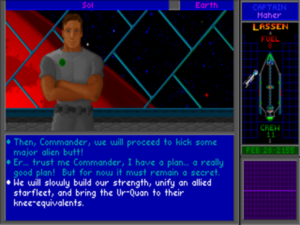
Star Control II takes itself seriously in the places where it’s important to do so, but never too seriously. Anyone bored with the self-consciously “dark” fictions that so often dominate in our current era of media will find much to appreciate here.
When asked to define what makes a good game, Paul Reiche once said that it “has to have a fun core, which is a one-sentence description of why it’s fun.” Ironically, Star Control II is an abject failure by this standard, pulling in so many directions as to defy any such holistic description. It’s a strategy game of ship and resource management; it’s an action game of ship-versus-ship combat; it’s an adventure game of puzzle-solving and clue-tracking. Few cross-genre games have ever been quite so cross-genre as this one. It really shouldn’t work, but, for the most part anyway, it does. If you’re a person whose ideal game lets you do many completely different things at every session, this might just be your dream game. It really is an experience of enormous richness and variety, truly a game like no other. Small wonder that it’s attracted a cult of players who will happily declare it to be nothing less than the best game ever made.
For my part, I have a few too many reservations to go quite that far. Before I get to them, though, I’d like to let Reiche speak one more time. Close to the time of Star Control II‘s release, he outlined his four guiding principles of game design. Star Control II conforms much better to these metrics than it does to that of the “one-sentence description.”
First, [games should be] fun, with no excuses about how the game simulates the agony and dreariness of the real world (as though this was somehow good for you). Second, they [should] be challenging over a long period of time, preferably with a few ability “plateaus” that let me feel in control for a period of time, then blow me out of the water. Third, they [should] be attractive. I am a sucker for a nice illustration or a funky riff. Finally, I want my games to be conceptually interesting and thought-provoking, so one can discuss the game with an adult and not feel silly.
It’s in the intersection between Reiche’s first and second principles that I have my quibbles with Star Control II. It’s a rather complicated, difficult game by design, which is fair enough as long as it’s complex and difficult in a fun way. Some of its difficulty, however, really doesn’t strike me as being all that much fun at all. Those of you who’ve been reading this blog for a while know that I place enormous weight on fairness and solubility when it comes to the games I review, and don’t tend to cut much slack to those that can only be enjoyed and/or solved with a walkthrough or FAQ to hand. On this front, Star Control II is a bit problematic, due largely to one questionable design choice.
Star Control II, you see, has a deadline. You have about five years before Earth is wiped out by the Ur-Quan (more precisely, by the eviller of the two factions of the Ur-Quan, but we won’t get into that here). Fans will tell you, by no means entirely without justification, that this is an essential part of the game. One of the great attractions of Star Control II is its dynamic universe which just keeps evolving, with or without your intervention: alien spaceships travel around the galaxy just like yours is doing, alien races conquer others and are themselves conquered, etc.
All of this is undoubtedly impressive from a game of any vintage, let alone one as old and technologically limited as this one. And the feeling of inhabiting such a dynamic universe is undoubtedly bracing for anyone used to the more static norm, where things only happen when you push them to happen. Yet it also has its drawbacks, the most unfortunate of which is the crushing sense of futility that comes after putting dozens of hours into the game only to lose it irrevocably. The try-and-try-again approach can work in small, focused games that don’t take long to play and replay, such as the early mysteries of Infocom. In a sprawling epic like this, however… well, does anyone really want to put those dozens of hours in all over again, clicking through page after page of the same text?
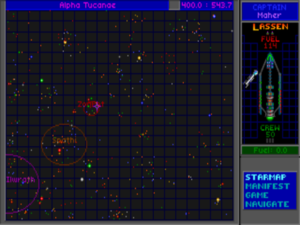
Star Control II‘s interface felt like something of a throwback even in its own time. By 1992, computer games had almost universally moved to the mouse-driven point-and-click model. Yet this game relies entirely on multiple-choice menus, activated by the cursor keys and/or a joystick. Toys for Bob was clearly designing with possible console ports in mind. (Star Control was ported to the Sega Genesis, but, as it happened, Star Control II would never get the same honor, perhaps because its sales didn’t quite justify the expense and/or because its complexity was judged unsuited to the console market.) Still, for all that it’s a little odd, the interface is well thought-through, and you get used to it quickly.
There’s an undeniable tension between this rich galaxy, full of unusual sights and entertaining aliens to discover, and the need to stay relentlessly on-mission if you hope to win in the end. I submit that the failure to address this tension is, at bottom, a failure of game design. There’s much that could have been done. One solution might have been to tie the evolving galaxy to the player’s progress through the plot rather than the wall clock, a technique pioneered in Infocom’s Ballyhoo back in 1986 and used in countless narrative-oriented games since. It can convey the impression of rising danger and a skin-of-the-teeth victory every time without ever having to send the player back to square one. In the end, the player doesn’t care whether the exhilarating experience she’s just had is the result of a meticulous simulation coincidentally falling into place just so, or of a carefully manipulated sleight of hand. She just remembers the subjective experience.
But if such a step is judged too radical — too counter to the design ethos of the game — other remedies could have been employed. To name the most obvious, the time limit could have been made more generous; Starflight as well has a theoretical time limit, but few ever come close to reaching it. Or the question of time could have been left to the player — seldom a bad strategy in game design — by letting her choose from a generous, moderate, and challenging time limit before starting the game. (This approach was used to good effect by the CRPG The Magic Candle among plenty of other titles over the years.)
Instead of remedying the situation, however, Reiche and his associates seemed actively determined to make it worse with some of their other choices. To have any hope of finishing the game in time, you need to gain access to a new method of getting around the galaxy, known as “quasi-space,” as quickly as possible. Yet the method of learning about quasi-space is one of the more obscure puzzles in the game, mentioned only in passing by a couple of the aliens you meet, all too easy to overlook entirely. Without access to quasi-space, Star Control II soon starts to feel like a fundamentally broken, unbalanced game. You trundle around the galaxy in your truck of a spaceship, taking months to reach your destinations and months more to return to Earth, burning up all of the minerals you can mine just to feed your engines. And then your time runs out and you lose, never having figured out what you did wrong. This is not, needless to say, a very friendly way to design a game. Had a few clues early on shouted, “You need to get into quasi-space and you may be able to do so here!” just a little more loudly, I may not have felt the need to write any of the last several paragraphs.
I won’t belabor the point any more, lest the mob of Star Control II zealots I can sense lurking in the background, sharpening their pitchforks, should pounce. I’ll say only that this game is, for all its multifaceted brilliance, also a product of its time — a time when games were often hard in time-extending but not terribly satisfying ways, when serious discussions about what constituted fair and unfair treatment of the player were only just beginning to be had in some quarters of the industry.
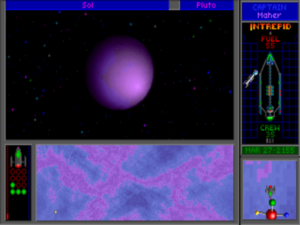
Searching a planet’s surface for minerals, lifeforms, and clues. Anyone who has played Starflight will feel right at home with this part of the game in particular.
Certainly, whatever our opinion of the time limit and the game’s overall fairness, we have to recognize what a labor of love Star Control II was for Paul Reiche, Fred Ford, and everyone who helped bring it to fruition, from Greg Johnson and Robert Leyland to all of the other writers and artists and testers who lent it their talents. Unsurprisingly given its ambition, the project went way beyond the year or so Accolade had budgeted for it. When their publisher put their foot down and said no more money would be forthcoming, Reiche and Ford reached deep into their own pockets to carry it through the final six months.
As the project was being wrapped up, Reiche realized he still had no music, and only about $1500 left for acquiring some. His solution was classic Toys for Bob: he ran an online contest for catchy tunes, with prizes of $25, $50, and $100 — in addition to the opportunity to hear one’s music in (hopefully) a hit game, of course. The so-called “tracker” scene in Europe stepped up with music created on Commodore Amigas, a platform for which the game itself would never be released. “These guys in Europe [had] just built all these ricky-tink programs to play samples out,” says Reiche. “They just kept feeding samples, really amazing soundtracks, out into the net just for kicks. I can’t imagine any of these people were any older than twenty. It makes me feel like I’m part of a bigger place.”
Upon its release on November 30, 1992 — coincidentally, the very same day as Dune II, its companion in mislabeled sequels — Star Control II was greeted with excellent reviews, whose enthusiasm was blunted only by the game’s sheer unclassifiability. Questbusters called it “as funny a parody of science-fiction role-playing as it is a well-designed and fun-to-play RPG,” and named it “Best RPG of the Year” despite it not really being a CRPG at all by most people’s definitions. Computer Gaming World placed it on “this reviewer’s top-ten list of all time” as “one of the most enjoyable games to review all year,” and awarded it “Adventure Game of the Year” alongside Legend Entertainment’s far more traditional adventure Eric the Unready.
Sales too were solid, if not so enormous as Star Control II‘s staying power in gamers’ collective memory might suggest. Like Dune II, it was probably hurt by being billed as a sequel to a game likely to appeal most to an entirely different type of player, as it was by the seeming indifference of Accolade. In the eyes of Toys for Bob, the developer/publisher relationship was summed up by the sticker the latter started putting on the box after Star Control II had collected its awards: “Best Sports Game of 1992.” Accolade was putting almost all of their energy into sports games during this period, didn’t have stickers handy for anything else, and just couldn’t be bothered to print up some new ones.
Still, the game did well enough that Toys for Bob, after having been acquired by a new CD-ROM specialist of a publisher called Crystal Dynamics, ported it to the 3DO console in 1994. This version added some eight hours of spoken dialog, but cut a considerable amount of content that the voice-acting budget wouldn’t cover. Later, a third Star Control would get made — albeit not by Toys for Bob but by Legend Entertainment, through a series of intellectual-property convolutions we won’t go into in this article.
Toys for Bob themselves have continued to exist right up to the present day, a long run indeed in games-industry terms, albeit without ever managing to return to the Star Control universe. They’re no longer a two-man operation, but do still have Paul Reiche III and Fred Ford in control.
To this day, Star Control II remains as unique an experience as it was in 1992. You’ve never played a game quite like this one, no matter how many other games you’ve played in your time. Don’t even try to categorize it. Just play it, and see what’s possible when a talented design team throws out all the rules. But before you do, let me share just one piece of advice: when an alien mentions something about a strange stellar formation near the Chandrasekhar constellation, pay attention! Trust me, it will save you from a world of pain…
(Sources: Compute!’s Gazette of November 1984; Compute! of January 1992 and January 1993; Computer Gaming World of November 1990, December 1990, March 1993, and August 1993; InterActivity of November/December 1994; Questbusters of January 1993; Electronic Gaming Monthly of May 1991; Sega Visions of June 1992; Retro Gamer 14 and 15. Online sources include Ars Technica‘s video interview with Paul Reiche III and Fred Ford; Matt Barton’s interviews with the same pair in Matt Chat 95, 96, and 97; Grognardia‘s interview with Reiche; The Escapist‘s interview with Reiche; GameSpot‘s interview with Reiche.
Star Control I and II are available as a package purchase at GOG.com. Another option for experiencing Star Control II is The Ur-Quan Masters, a loving open-source re-creation based on Toys for Bob’s 3DO source code.)
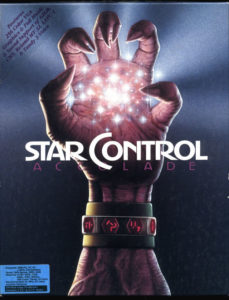
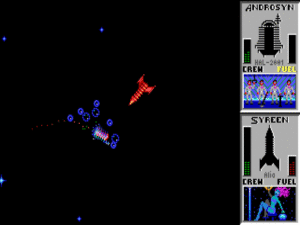

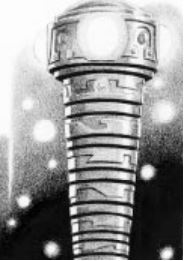
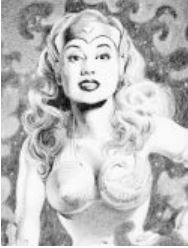
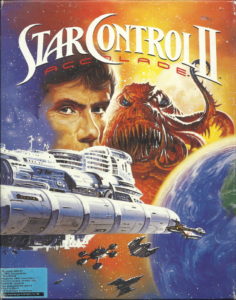
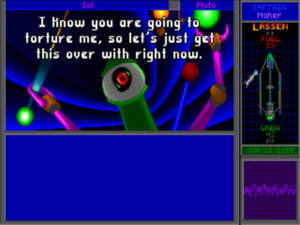











Infinitron
December 21, 2018 at 5:39 pm
Quasi-space, not quad-space.
Jimmy Maher
December 21, 2018 at 6:16 pm
Thanks!
JudgeDeadd
December 21, 2018 at 5:41 pm
“The Yehat, who breed like rabbits”
That’s actually the Shofixti.
Jimmy Maher
December 21, 2018 at 6:16 pm
Thanks!
Christopher Floyd
December 21, 2018 at 7:33 pm
When I was reading your piece on Cryo’s Dune, I started trying to piece together when (and if!) you might get to Star Control II. I made the connection because they’re both odd story-strategy games–although SC2 is another step or two further in ambition. I call it a “kitchen sink” game, for as many genres as it encompasses.
It’s also my favorite game of all time, and I think one that’s still very enjoyable today if you can get over the need to take your own notes. And maybe occasionally peek at a map that tells you where some interesting content is, since you probably don’t have the time and patience for all that free-form open-world exploration we relished (?) in 1992.
Thanks for yet another deep-trawling article.
Pedro Timóteo
December 21, 2018 at 8:04 pm
I’ve always found the time limit pretty generous; I believe my brother and I (playing on separate computers but sharing our discoveries with each other) were able to finish the game from a “descendant” save of our initial game (re-loading when dying, or when screwing up the game in some way — keeping several saves to prevent that –, but never restarting it from the beginning). Also, there are in-game ways to increase it (basically getting other races to interfere in the Ur-Quan civil war so that the Kohr-Ah take a year or two longer to win).
You also mention Cyborg Mode, which (unless you’re bad at action games or don’t enjoy them at all, and there’s nothing wrong in either case, of course) is a far from optimal way to play the game, as there are tricks that can be used to overcome the AI. Most people go for a Spathi ship, which can beat virtually any computer-controlled opponent in the game as long as you have a lot of patience… which I don’t, so I typically focus on upgrading the flagship until it can kill almost any enemy in 2-3 shots. You can also get a lot of extra resources by not “solving” the problem with the probes for a long while, since they provide a lot when destroyed. And getting tech upgrades from the Melnorme quickly is essential.
By the way, this and Ultima 7 are probably my favorite PC games of all time. Funny how both are from the same year…
Jimmy Maher
December 21, 2018 at 8:19 pm
I think a big problem with the action game today is that you really need a joystick to play it properly, which seems to be an increasingly rare peripheral among PC gamers. I do have one, but I was playing Star Control II on my laptop when I was traveling, so I wound up just using the Cyborg Mode for the most part.
Andrew
December 21, 2018 at 10:37 pm
I must have played this game to completion over a dozen times, and spent hundreds of hours playing Super Melee. All on the keyboard. In fact Super Melee would have had two people hunched over one keyboard, locked in conflict. The precision required for some strategies (hiding between Ur-Quan Dreadnought firing arcs, for example) seemed to suit the keyboard.
With respect to the time limit – the game was quite artfully designed here – in that there was a fairly long sequence of events you needed to complete to get access to the device you needed to accelerate the fusion of Chenjesu and Mmrnmhrm, but if the clock had run down and the Kohr-Ah had started their pogrom, you could wait for them to annigliate (damn) the Mycon, and then just nip down to their planet, snag the Sun Device, and then leg it to Procyon to do the necessary. This was how I managed to complete the game the first time I played it, and I can still remember the panic and tension as I rushed around the galaxy, trying to get to the Sa Matra before the Kohr Ah reached Earth.
I think there were other items that were defended by unbeatable fleets of ships that you could acquire this way, if you’d failed to get them the “correct” way.
Pedro Timóteo
December 22, 2018 at 11:48 am
Oh, yes, keyboard all the way. :)
Maybe it’s because I grew up with the ZX Spectrum, where every single game supported the keyboard (unlike, say, the C64 or the Amiga, where almost every game required a joystick), but, to me, if a game’s controls are digital, then the best way to play it is still using a keyboard — typically my right hand for directions, and the left one for any fire buttons. It took me literally years, back in the late 90s (PS1) and early 2000s (GameCube) to get used to a controller, especially analog ones (just going in a straight line can still be tough, sometimes…), and, to this day, if playing something in an emulator, I prefer to use keys.
The “the bad guys solve all the puzzles for you at the end of the game to give you one last chance” bit is something I only found out about years later, when reading forums. AFAIK it’s pretty unique to SC2 — at least I can’t think of any other example.
Jimmy Maher
December 22, 2018 at 1:09 pm
Hmm… I was reading some old discussion threads about the game, as you do, before writing this article, and a fair number of people were saying the difference between and keyboard and joystick was like night and day. Obviously mileages vary more than expected.
As for me, I knew it wasn’t the sort of thing I’d enjoy or ever be very good at pretty much the moment I saw it, so I didn’t sweat using Cyborg Mode too much. Third-person action games with fiddly controls just aren’t my forte — but I recognize that to be a criticism of me, what with my sausage fingers and middle-aged reflexes, rather than the game.
Lisa H.
December 22, 2018 at 11:05 pm
My friends and I played Super Melee for hours without a joystick, using the four-hands-on-a-keyboard method. (I’ve never owned a PC joystick, actually.) It is not my typical kind of game but I don’t find it that hard in general; as noted, some kinds of ships have strong advantages over others. Within the story mode of the game, though, with a few exceptions I agree with Pedro that beefing up your flagship as much as possible is a quicker strategy and that a Spathi ship is a general good choice otherwise. (Whenever I replay SC2 I have a kind of superstition about making sure that Fwiffo, specifically, makes it all the way from Pluto to the endgame with me.)
Andrew
December 24, 2018 at 1:48 pm
Fwiffo is the best. I never let him die either :)
M. Casey
December 25, 2018 at 2:14 am
Fwiffo is the Dogmeat of SC2. Even as he becomes hopelessly outclassed, it’s still tempting to keep him on as a mascot. :)
David Scotton
December 21, 2018 at 8:19 pm
I agree with your comments on time limits generally, but I never had a problem with the time limit in this game. My biggest complaint about the game is something you didn’t really mention: the resource gathering aspect of the game is just not fun – it’s basically exactly the kind of agony that you quote Reiche as saying games should avoid. The first time I played I exploited the shuttle-sale wraparound bug to avoid having to collect resource (after reading the wraparound-related quotes about the Ilwrath in this article I wonder if that bug was there intentionally). Anyway, aside from that it’s a great game.
Nate
December 22, 2018 at 9:39 am
I have to agree: I started playing The Ur-Quan Masters, took about two attempts at resource mining with the shuttle and went ‘okay, it’s one of THOSE games’ and ran far, far away. I haven’t regretted it. The story might be great but if I have to do that planet mining minigame all the time? No thanks. Life’s far too short for that.
I guess people really do want very different things from their games. I’m at the point in my life where ‘repeat random mazey stuff looking for random loot’ is not one of them.
sam
December 21, 2018 at 9:22 pm
“Ur-Quan Heirarchy” should presumably have ‘hierarchy’, or a (sic).
Jimmy Maher
December 22, 2018 at 5:54 am
Thanks!
Martin
December 22, 2018 at 12:50 am
So Chandrasekhar, as in the Indian physicist Nobel laureate. Sure why wouldn’t I go there?
Margaret Trauth
December 22, 2018 at 1:35 am
“Reiche and Ford planned to keep their company deliberately tiny, signing only short-term contracts with outsiders to do the work that they couldn’t manage on their own.”
Things change. Oh how things change. The credits for the Toys For Bob remake of the Spyro trilogy go on for about twenty minutes.
And Reiche and Ford are nowhere to be seen in them.
The Eidolon
December 22, 2018 at 3:08 am
The Liebermann triplets appear to have lost an N in the caption.
Also, fun fact, another famous TSR alum, Erol Otus, did some of the art for the aliens in the manual for Star Control 1.
Jimmy Maher
December 22, 2018 at 5:53 am
Thanks!
Erol Otus actually has a long history with Paul Reiche III. He was one of the first people the latter played Dungeons & Dragons with and worked with him on the early self-published tabletop stuff. Their professional paths have crossed repeatedly in the decades since.
Chmmr
December 22, 2018 at 9:56 am
God bless the DOS version’s lander bug loop-hole allowing unlimited RUs!
whomever
December 22, 2018 at 10:19 am
Random aside, but since this is I believe the first time “Archon” is mentioned, I actually do think it was one of the best games of its era. I played it extensively with my friend on his Atari 800XL and it really does stand up there in the multi-player fun category with the likes of M.U.L.E.
Jimmy Maher
December 22, 2018 at 11:24 am
I actually wrote a whole article about it almost six years ago (how time flies!): https://www.filfre.net/2013/02/free-fall-part-1-archon. It’s a very good design, but marred somewhat in my opinion by a tendency to devolve into a passive stalemate toward the endgame.
Will O'Neill
December 22, 2018 at 2:29 pm
This was a fantastic read on the greatest game ever made. Thank you!
Laertes
December 22, 2018 at 10:22 pm
Is the open source remake also a cut version as the 3DO one?
Jimmy Maher
December 22, 2018 at 11:16 pm
I’m not actually sure whether all of the cut content has been added back in by now or not. I’ve heard that at least for a time a vital clue was missing from the remake, making the game effectively unwinnable without recourse to outside knowledge; no idea whether that’s been fixed. Even if I hadn’t felt obligated to play the original for the sake of the history angle, I’d be a little reluctant to trust the remake without further research. If your style of play is to use a lot of FAQs and so on, of course, this may be less of a concern.
But maybe someone who knows more about the remake will chime in with firmer information.
Pedro Timóteo
December 23, 2018 at 10:25 am
About the remake, I’m assuming the missing clue is the Mycon telling you where their homeworld is (*) (since you later in the game need to go there for a reason — and it’s *not* the same location as their Juffo-Wup “special place”). Now, I think I remember reading that that had been fixed in the past decade, but a bit of googling couldn’t find it — only forum threads from 2003-2005 asking for help.
Since I haven’t played UQM in a while, and I always find it a joy to do so, I’ll try to do so in the next couple of days, and will share here if that bug has since been fixed.
Jimmy Maher
December 23, 2018 at 10:45 am
Awesome! Thank you!
Laertes
December 23, 2018 at 11:49 am
Thanks Pedro & JImmy,
I am not going to play it myself, at least not in the short term, even if I installed it long time ago, it was just curiosiy.
Pedro Timóteo
December 24, 2018 at 10:02 am
Just checked (basically by starting a new game, doing the initial bits in the solar system, buying a lot of fuel, and going straight to the Mycon area), and, yes, the very first Mycon you meet tells you the location of their homeworld. So apparently it was fixed (which probably included recording the missing line with a similar-sounding voice).
That screenshot is from the HD version of UQM, by the way (the “regular” UQM uses the original 3DO graphics).
CdrJameson
December 22, 2018 at 10:33 pm
Starflight/SC II clearly had an influence on the design of Mass Effect (dropping onto planet for resource collection – which they also dropped because it was tedious) but it’s odd to compare such a relatively recent SFRPG and see that it’s so tiny and constrained in scope and freedom in comparison to these much older ones. By ME III they had some ship-scale movement between systems, but it was still pretty trivial.
It’s not like the structure of these games is even difficult to replicate, or that it was unique – the Megatraveller games had similarly non-linear movement between planets – it’s just curious that it hasn’t been really used much since.
Jimmy Maher
December 22, 2018 at 11:22 pm
Yes, it’s hard to understand why this whole line turned out to be something of an evolutionary dead end. Odd that we get about a dozen ambitious new 4X space games every year, and nothing that takes a more embodied approach to the whole grandeur-of-the-cosmos thing. The only remotely kindred spirit that’s been released recently is No Man’s Sky, and that turned into a big disappointment for just about everyone, thanks largely to an over-reliance on procedurally-generated content (a bane of a lot of modern games, it seems).
Bluddy
December 26, 2018 at 9:55 pm
This is a great point, in that SC2 was the epitome of taking procedural generation and then dropping a full-scale plot onto it. If only someone could do that again, instead of creating a mass of procedural content nobody cares about.
Gnoman
December 29, 2018 at 4:38 am
I’d argue that Stellaris takes some pretty big leaps back toward this sort of model, even if it isn’t quite there.
Pedro Timóteo
December 24, 2018 at 10:20 am
Just found a typo: “to Toy’s for Bob’s own space epic”
Toy’s -> Toys
Jimmy Maher
December 24, 2018 at 11:11 am
Thanks so much… on both counts. ;) Good to know the problem was fixed.
M. Casey
December 25, 2018 at 3:00 am
Oh, this was one of my favorite games of the era. I remember trading a copy of Legends of Valour (which was fine in theory, awful in execution) for it on USENET. One of the best trades of my life; I still have the floppies around somewhere.
Anyway, a few thoughts:
1. The time limit, as others had mentioned, was pretty generous all told. I lost the first time through but later found out it wasn’t by much.
2. The grind of RU gathering wasn’t at all bad at the time–particularly since you should be upgrading your landers once you figured out how trading with the Melnorme worked–but it sure is a dated mechanic today.
3. As you read more science fiction you’re able to see how liberally Reiche & Ford borrowed from other works, but man, the story’s so fun I can’t hold it against them. Loved the story of how the Kohr-Ah developed and how the Ur-Quan dealt with the Dnyarri problem.
4. After a few playthroughs you figure out a preferred early game strategy… for me it was eschewing combat early, using Alliance mascot Fwiffo to take out the unavoidable Slylandro or Ur-Quan encounter, and getting the Orz to join up for *parties* as soon as possible because in the hands of an able commander they’re extremely strong and versatile. Eventually, of course, the mothership becomes your best ship.
5. To be honest I can’t imagine handing off combat duties to the AI, but I get that it’s not your thing.
6. Your essay about Covert Action has some interesting contrasts here: why did Covert Action, another collection of minigames by a brilliant designer, fail when Star Control II is a masterpiece? I’d say it was a matter of story but I’m curious what you might think.
7. As always, great article Jimmy.
Jimmy Maher
December 25, 2018 at 8:57 am
There are such big differences between Covert Action and Star Control II, even outside their fiction — one is scenario-based, the other a single all-encompassing quest — that I’d hesitate to compare them too closely. But I’d have to stick to my thesis that Covert Action failed primarily because its procedurally-generated stories just weren’t interesting or compelling enough to make you care about them. Whatever else you can say about it, Star Control II certainly doesn’t have this problem. There’s an interesting discussion in Reiche and Ford’s video on Ars Technica, linked to in the sources above. It seems Reiche originally wanted to make a procedurally-generated, realistic galaxy, but the end result was boring, so they threw it out and made a less realistic but much more fun hand-crafted galaxy. If not quite the same thing as the question of hand-crafted versus procedurally-generated story, this is definitely on the same wavelength. (Ironically, the procedurally-generated galaxy fell afoul of one of Sid Meier’s rules for game design, which says it should be the *player*, not the designer or the programmer exploring this or that interesting system, who has the fun. It’s *amazing* how many games this rule applies to.)
Gordon R Cameron
December 27, 2018 at 11:23 pm
>In the end, the player doesn’t care whether the exhilarating experience she’s just had is the result of a meticulous simulation coincidentally falling into place just so, or of a carefully manipulated sleight of hand. She just remembers the subjective experience.
As Luke Skywalker would say, *I* care!
Star Control II fell into my brief non-gaming window when I was in college with nothing but an old Amiga 500. Consequently I have much fonder memories of its predecessor. I’ve tried once or twice to give II a proper playthrough. It hasn’t stuck, yet, but I’ll get to it in time, probably.
Ross
January 2, 2019 at 11:45 pm
I never played Star Control II, but I did play and really enjoy ‘Protostar’, which I’d heard was similar. Went to look it up today and… Lo and behold, Protostar was originally conceived as a third Starflight game.
Jaakko Markus Seppälä
January 3, 2019 at 11:57 am
Thank you for writing about the best game of all time, Jimmy! This really made my Christmas.
Reading your article got me thinking what it was that made Star Control II so captivating for me as a kid, and to a considerable extent, even today. Obviously the memorable aliens, the kick-ass music, the very playable space battle subgame and a perfect balance between wacky humor and a serious storyline…
However, I think that the biggest thing for me was how the game made you feel you weren’t just playing a game. It made you feel you were in another universe, full of secrets that lay waiting to be discovered! It had a lot to do with the fact that you had to – or were given the freedom to – fly everywhere.
Some gamers might find such approach tedious. I loved it. How disappointed I was to play Star Control 3 some years later: it junked that illusion of freedom by limiting your movements to insta-teleporting between star systems with a mouse-click. Even worse was the sucky minimap used for moving within the star systems. Never seen a more efficient way to reduce the majesty of interplanetary exploration in deep space to something akin to dragging icons on a four-color proto-Windows desktop in safe mode.
To top it all off, SC3 cheats by hiding some systems from the starmap, making them wholly inaccessible until the player completes certain plot points. In SC2, some places were basically inaccessible before you found necessary objects or clues for dealing with the obstacles, yes. But you could still stumble across those places on your own, you could still _find_ them. That makes one heck of a difference when it comes to how the game universe feels.
All this “streamlining” in SC3 may have been made in the name of playability. For me, it just made the game feel “gamey”. To be fair, SC3 sported a metric ton of other flaws as well, but this one was the definite immersion-breaker for me.
I guess I’ve always been sucker for the open-universe approach. Another game that fascinated the heck out of me back then was Mercenary: Escape from Targ, and its insanely more difficult sibling, The Second City. I sank countless hours into them even if, at the age of eight, I couldn’t understand half of what was going on or what I should have been doing…
It’s strange how few games after that have managed to evoke the same sense of sandbox wonder.
Jaakko Markus Seppälä
January 3, 2019 at 12:22 pm
Can’t resist a modest plug here:
We created the Ur-Quan Masters HD (a.k.a. a high-definition version of SC2) together with Damon Czanik and a heap of other hardcore fans some years ago. I was the lead programmer in the project.
The game turned out pretty neat-looking! In addition to polishing the graphics we fixed a bunch of bugs left in the original SC2 and introduced a good number of new features :) So, if you want to try something more modern than the old 320×240 resolution, go grab your copy at at http://sourceforge.net/projects/urquanmastershd. There are Windows, OS X and Linux versions available.
Even better, Matt Bentley has spearheaded a project called Ur-Quan Masters HD Remix, also available at Sourceforge. The remix version corrects even more bugs, some of which we missed and some that we somehow introduced into the code (oops!). The remix version seems to be available only for Windows though: http://sourceforge.net/projects/ur-quan-masters-hd-remix
Captain Kal
January 4, 2019 at 9:12 pm
Many thanks, Jaakko, for you and your team!!! The HD version is great!!
Lisa H.
January 8, 2019 at 7:46 pm
I always wondered what was the difference between HD and HD Remix!
DZ-Jay
January 17, 2019 at 6:02 pm
About the timed events, you shouldn’t really fault them for that. At the time, it was not really clear that an actual simulation of the world, running in real time, was a bad thing for adventure or role-playing games. This was a similar problem to what text-adventure developers faced when originally trying to convert literature to so-called “interactive fiction” (Infocom included), while keeping all the trappings of a plot arc and predictable character development in place.
It was so prevalent back then, that even design luminaries like Ron Gilbert fell for the illusory “real time simulation” chimera when he first implemented Maniac Mansion in 1987. He has since then mentioned the timed events in that game as a regrettable flaw that detracts from an otherwise enjoyable adventure.
He obviously learned from that mistake, but it wasn’t until much later that he would reflect on it as an actual design principle anti-pattern, so critical, that he included it specifically on his treatise on Why Adventure Games Suck, as its own section titled, “Real time is bad drama.”
I saw that after bashing the designers over this point you conceded that the game was a product of its time, but I still feel that the bashing was unwarranted. Yes, it’s fine (and perhaps necessary) to point out that things have changed and that we know better now, but your comments on the topic seem a little drastic. Is it really such a critical “failure in design” if it was actually de rigueur to do so at the time?
Anyway, by your description, it does sound like an net resting game, and I will probably try it out. :)
dZ.
DZ-Jay
January 17, 2019 at 6:13 pm
“An net resting game” should be, of course, “an interesting game. Damn, you, Siri!!!
dZ.
Terence
August 11, 2019 at 4:15 pm
You might want to update the last footnote regarding the legal dispute as it appears the parties have put aside their differences.
https://www.pcgamer.com/star-control-lawsuit-settled-both-sides-will-cooperate-on-current-and-future-games/
Jimmy Maher
August 12, 2019 at 11:48 am
That’s great to see. Thanks!
Tsubasanut
December 26, 2019 at 11:30 am
That was a nice and informative long read. SC2 is a gaming pinnacle for me, where graphics, gameplay, plot and music were just perfect.
I am the minority who throughout enjoyed lander minigame. I also spend a lot of time looking for games similar to SC2, which should have space exploration, resources gathering and aliens. Up to this time the only one managed to do so decently (apart from Starflight series of cause) was new Star Control Origin. However, some were unique enough to be entertaining. Namely: Microprose’s Hyperspeed, Protostar, Alien legacy, Parkan series, Ironseed and Star Fleet Armada Rogue Adventures.
Fronzel
February 20, 2021 at 5:59 am
Star Control 2 was ported to the 3DO which version added often amusing voice-acting with the right cartoony feel to fit the art and writing.
Ben
October 28, 2025 at 9:36 pm
Illwrath -> Ilwrath (4x)
Jimmy Maher
October 30, 2025 at 11:46 am
Thanks!